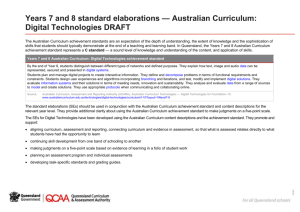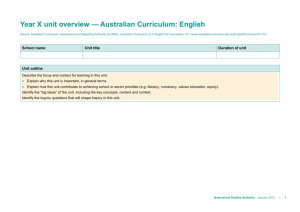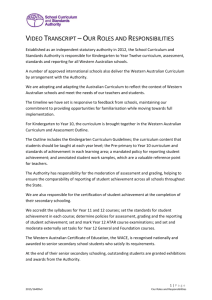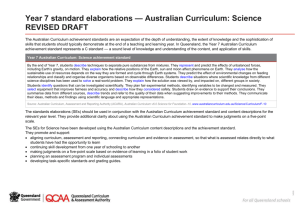Years 9 and 10 standard elaborations * Australian Curriculum
advertisement
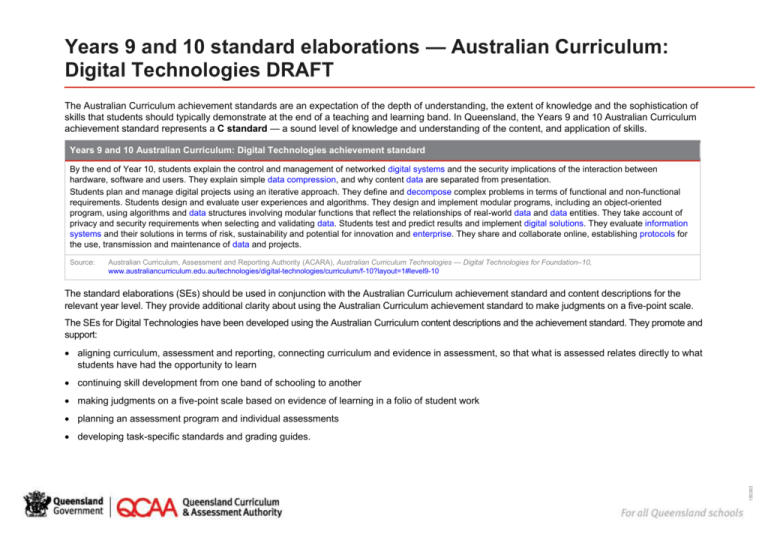
Years 9 and 10 standard elaborations — Australian Curriculum: Digital Technologies DRAFT The Australian Curriculum achievement standards are an expectation of the depth of understanding, the extent of knowledge and the sophistication of skills that students should typically demonstrate at the end of a teaching and learning band. In Queensland, the Years 9 and 10 Australian Curriculum achievement standard represents a C standard — a sound level of knowledge and understanding of the content, and application of skills. Years 9 and 10 Australian Curriculum: Digital Technologies achievement standard By the end of Year 10, students explain the control and management of networked digital systems and the security implications of the interaction between hardware, software and users. They explain simple data compression, and why content data are separated from presentation. Students plan and manage digital projects using an iterative approach. They define and decompose complex problems in terms of functional and non-functional requirements. Students design and evaluate user experiences and algorithms. They design and implement modular programs, including an object-oriented program, using algorithms and data structures involving modular functions that reflect the relationships of real-world data and data entities. They take account of privacy and security requirements when selecting and validating data. Students test and predict results and implement digital solutions. They evaluate information systems and their solutions in terms of risk, sustainability and potential for innovation and enterprise. They share and collaborate online, establishing protocols for the use, transmission and maintenance of data and projects. Source: Australian Curriculum, Assessment and Reporting Authority (ACARA), Australian Curriculum Technologies — Digital Technologies for Foundation–10, www.australiancurriculum.edu.au/technologies/digital-technologies/curriculum/f-10?layout=1#level9-10 The standard elaborations (SEs) should be used in conjunction with the Australian Curriculum achievement standard and content descriptions for the relevant year level. They provide additional clarity about using the Australian Curriculum achievement standard to make judgments on a five-point scale. The SEs for Digital Technologies have been developed using the Australian Curriculum content descriptions and the achievement standard. They promote and support: aligning curriculum, assessment and reporting, connecting curriculum and evidence in assessment, so that what is assessed relates directly to what students have had the opportunity to learn continuing skill development from one band of schooling to another making judgments on a five-point scale based on evidence of learning in a folio of student work planning an assessment program and individual assessments 150383 developing task-specific standards and grading guides. Years 9 and 10 Digital Technologies standard elaborations A B C DRAFT D E comprehensive explanation of: detailed explanation of: explanation of: description of: statements about: Digital systems the control and the control and the control and the control and the control and Representation of data Knowledge and understanding Understanding dimension The folio of student work has the following characteristics: comprehensive explanation of simple data compression, and why content data are separated from presentation management of networked digital systems the security implications of the interaction between hardware, software and users management of networked digital systems the security implications of the interaction between hardware, software and users detailed explanation of simple data compression, and why content data are separated from presentation management of networked digital systems the security implications of the interaction between hardware, software and users explanation of simple data compression, and why content data are separated from presentation Years 9 and 10 standard elaborations — Australian Curriculum: Digital Technologies DRAFT management of networked digital systems management of networked digital systems the security implications of the interaction between hardware, software and users the security implications of the interaction between hardware, software and users description of simple data compression, and why content data are separated from presentation statements about simple data compression and why content data are separated from presentation Queensland Curriculum & Assessment Authority June 2015 Page 2 of 10 A B C D E Defining Designing and implementing Processes and production skills Evidence of creating digital solutions Skills dimension Collecting, managing and analysing data The folio of student work has the following characteristics: discerning selection and validation of data, taking account of privacy and security requirements informed selection and validation of data, taking account of privacy and security requirements selection and validation of data, taking account of privacy and security requirements partial selection and validation of data, taking account of aspects of privacy and security requirements fragmented selection and validation of data, taking account of aspects of privacy and security requirements discerning definition and decomposition of complex problems in terms of functional and non-functional requirements informed definition and decomposition of complex problems in terms of functional and non-functional requirements definition and decomposition of complex problems in terms of functional and non-functional requirements partial definition and decomposition of complex problems in terms of functional and non-functional requirements fragmented definition and decomposition of problems discerning design and evaluation of user experiences and algorithms informed design and evaluation of user experiences and algorithms design and evaluation of user experiences and algorithms partial design and explanation of user experiences and algorithms fragmented design and statements about user experiences and algorithms discerning design and proficient implementation of modular programs, including an objectoriented program, using algorithms and data structures involving modular functions that reflect the relationships of real-world data and data entities informed design and effective implementation of modular programs, including an objectoriented program, using algorithms and data structures involving modular functions that reflect the relationships of real-world data and data entities design and implementation of modular programs, including an objectoriented program, using algorithms and data structures involving modular functions that reflect the relationships of real-world data and data entities partial design and implementation of modular programs using algorithms and data structures fragmented design and implementation of modular programs comprehensive testing and prediction of results and proficient implementation of digital solutions reliable testing and prediction of results and effective implementation of digital solutions testing and prediction of results and implementation of digital solutions partial testing and prediction of results and partial implementation of digital solutions fragmented testing and prediction of results or fragmented implementation of digital solutions Years 9 and 10 standard elaborations — Australian Curriculum: Digital Technologies DRAFT Queensland Curriculum & Assessment Authority June 2015 Page 3 of 10 A B C D E Key Evaluating Collaborating and managing Processes and production skills Evidence of creating digital solutions Skills dimension The folio of student work has the following characteristics: discerning evaluation of information systems and their solutions in terms of risk, sustainability and potential for innovation and enterprise informed evaluation of information systems and their solutions in terms of risk, sustainability and potential for innovation and enterprise evaluation of information systems and their solutions in terms of risk, sustainability and potential for innovation and enterprise explanation of information systems and their solutions description of information systems and their solutions discerning planning and management of digital projects using an iterative approach informed planning and management of digital projects using an iterative approach planning and management of digital projects using an iterative approach partial planning and management of digital projects using an iterative approach fragmented planning and management of digital projects proficient sharing and collaboration online, establishing comprehensive and effective protocols for the use, transmission and maintenance of data and projects. effective sharing and collaboration online, establishing effective protocols for the use, transmission and maintenance of data and projects. sharing and collaboration online, establishing protocols for the use, transmission and maintenance of data and projects. partial sharing and collaboration online, using protocols for the use, transmission and maintenance of data and projects. fragmented sharing and collaboration online, using protocols. Shading emphasises the key aspects of the achievement standard and qualities that discriminate between the A–E descriptors. Key terms are described overleaf. Years 9 and 10 standard elaborations — Australian Curriculum: Digital Technologies DRAFT Queensland Curriculum & Assessment Authority June 2015 Page 4 of 10 Notes Australian Curriculum common dimensions The SEs describe the qualities of achievement in the two dimensions common to all Australian Curriculum learning area achievement standards — understanding and skills. Dimension Description understanding the concepts underpinning and connecting knowledge in a learning area, related to a student’s ability to appropriately select and apply knowledge to solve problems in that learning area skills the specific techniques, strategies and processes in a learning area Terms used in Years 9 and 10 Digital Technologies SEs The following terms are used in the Years 9 and 10 Digital Technologies SEs. They help to clarify the descriptors, and should be read in conjunction with the ACARA Technologies glossary: www.australiancurriculum.edu.au/technologies/glossary. Term Description algorithm the step-by-step procedures required to solve a problem; see also computational thinking apply; application use or employ in a particular situation aspects particular parts or features binary the use of two states or permissible values to represent data, such as the on and off position of a light switch or the transistors in a computer silicon chip that can be in either the electrical state of ON or OFF; typically represented as a series of single digits referred to as binary digits (or bits) due to each taking on the value of either 0 or 1; the image below shows how a dashed line might be represented in binary ON and OFF states for binary code collaborating and managing (technologies process) creating and communicating information, especially online, by creating websites, and interacting safely using appropriate technical and social protocols; in Digital Technologies, students should be given opportunities to develop collaborating and managing skills progressively: in Prep to Year 4, students communicate ideas and information in Year 5 to Year 6, students manage, create and communicate ideas and information in Year 7 to Year 10, students independently and collaboratively manage projects to create interactive solutions collecting, managing and analysing data involves the nature and properties of data, how they are collected and interpreted using a range of digital systems and peripheral devices and interpreting data when creating information comprehensive detailed and thorough, including all that is relevant computational a problem-solving method that involves various techniques and strategies that can Years 9 and 10 standard elaborations — Australian Curriculum: Digital Technologies DRAFT Page 5 of 10 Queensland Curriculum & Assessment Authority June 2015 Term Description thinking be implemented by digital systems; techniques and strategies include organising data logically, breaking down problems into parts (decomposing), defining abstract concepts, and designing and using algorithms, patterns and models creation; create; creating putting elements together to form a coherent or functional whole; reorganising elements into a new pattern or structure through designing, planning, or implementing; creating requires users to put parts together in a new way or synthesise parts into something new and different a new form or product criteria for success a descriptive list of essential features against which success can be measured; may be predetermined, negotiated with the class or developed by students; compilation of criteria for success involves: literacy skills to select and use appropriate terminology clarifying the project task and defining the need or opportunity to be resolved critiquing a careful judgement in which opinions are given about the positive and negative aspects of something; considers good as well as bad performances, the individual parts, relationships of the individual parts and the overall performance; see also evaluating data the discrete representation of information using number codes; may include characters (alphabetic, numbers, symbols), images (still and moving), sounds and instructions that can be manipulated, stored and communicated by digital systems; in Digital Technologies Years 9 and 10, data is categorical and relational decompose to separate a complex problem into parts to allow it to be more easily understood; see also computational thinking defining (technologies process) describes the problem and/or opportunity and states what is required of the solution description; describe give an account of characteristics or features designing (technologies process) states what is required of the solution detailed meticulous; including many of the parts Years 9 and 10 standard elaborations — Australian Curriculum: Digital Technologies DRAFT Page 6 of 10 Queensland Curriculum & Assessment Authority June 2015 Term Description digital solution; digital solutions the result (or output) of transforming data into information or action using digital systems, skills, techniques and processes to meet a need or opportunity; in Digital Technologies: students create solutions that will use data, require interactions with users and within systems, and will have impacts on people, the economy and environments solutions may be developed using combinations of readily available hardware and software applications, and/or specific instructions provided through programming (e.g. instructions for a robot, an adventure game, products featuring interactive multimedia including digital stories, animations and websites) students should have opportunities to develop solutions progressively: in Years 7 and 8, students create a range of digital solutions (e.g. interactive web applications, programmable multimedia assets, simulations of relationships between objects in the real world) in Years 9 and 10, students analyse problems and design, implement and evaluate a range of digital solutions (e.g. database-driven websites, artificial intelligence engines, simulations) digital systems digital hardware and software components (internal and external) used to transform data into digital solutions; when digital systems are connected they form a network; for example: a smartphone is a digital system that has software (apps, an operating system), input components (e.g. touch screen, keyboard, camera and microphone), output components (e.g. screen and speakers), memory components (e.g. silicon chips, solid state drives), communication components (e.g. SIM card, wi-fi, bluetooth or mobile network antennas), and a processor made up of one or more silicon chips a desktop computer with specific software and hardware components for dairy farming; the computer is connected via cables to milking equipment and via wi-fi to sensors that read tags on the cows; through these hardware components the software records how much milk each cow provides; such systems can also algorithmically control attaching milking equipment to each cow, providing feed and opening gates digital technologies any technologies controlled using digital instructions, including computer hardware and software, digital media and media devices, digital toys and accessories, and contemporary and emerging communication technologies; these technologies are based on instructions given using binary (0 or 1) code that invariably mean one or more processors are present to respond to these instructions; computers, smartphones, digital cameras, printers and robots are all examples of digital technologies discerning showing good judgment to make thoughtful choices; in Digital Technologies, discerning includes informed effective meeting the assigned purpose in a way that produces a desired or intended result enterprise a project or activity that may be challenging, requires effort and initiative and may have risks Years 9 and 10 standard elaborations — Australian Curriculum: Digital Technologies DRAFT Page 7 of 10 Queensland Curriculum & Assessment Authority June 2015 Term Description evaluate; evaluating (technologies process) measures performance against established criteria; estimates the nature, quality, ability, extent or significance to make a judgment determining the value; see also critiquing; in Digital Technologies, evaluating includes: solutions that have been developed by students examining how well existing information systems meet different needs explanation; explain provide additional information that demonstrates understanding of reasoning and/or application file transfer protocol (FTP) a set of rules or standards for transmitting files between digital systems on the internet; see protocols fragmented disjointed, incomplete or isolated functional design of products, services or environments to ensure they are fit for purpose and meet the intended need or market opportunity and identified criteria for success hypertext transfer protocol (HTTP) a set of rules or standards for transferring files and messages on the world wide web, specifically to allow linking of files and text; provides a standard for web browsers to render pages (i.e. present them in an intended form) and servers to communicate; see protocols identification; identify to establish or indicate who or what someone or something is implement; implementing; implementation to put into effect by means of a plan or procedure; in Digital Technologies, implementing a solution involves using specific software functions and items of hardware information systems the combination of digital hardware and software components (digital systems), data, processes and people that interact to create, control and communicate information informed having relevant knowledge; being conversant with the topic; in Digital Technologies, informed refers to the underpinning knowledge, understanding and skills of processes and production skills when solving problems and creating solutions innovation something newly introduced; a creation (a new device or process) resulting from study and experimentation interactive; interaction the back-and-forth dialog between the user and the computer; computer games are always interactive, and most computer applications are interactive (i.e. the user selects a task and the computer carries it out; then the user selects another); many web pages are interactive and increasingly function like locally installed applications iteration; iterative repetition of a process or set of instructions in computer programming, where each repeated cycle builds on the previous; typically this uses a FOR loop command with a counter , e.g. for number = 1 to 9 sum = sum + number Years 9 and 10 standard elaborations — Australian Curriculum: Digital Technologies DRAFT Page 8 of 10 Queensland Curriculum & Assessment Authority June 2015 Term Description object-oriented programming language (OOP) a programming language that supports the object-oriented programming paradigm (e.g. C++, Eiffel, Java, Python and Scala); objects represent a combination of data (the attributes of an object) and the actions that can be performed on or with that data (the methods of the object); the valid attributes and methods of an object are defined by its class, and these attributes and methods can be inherited from the definition of another class partial attempted; incomplete evidence provided plan; planning a scheme of action or procedure; a detailed proposal for doing something processes and production skills the skills needed to create digital solutions; see technologies processes producing actively realising (making) designed solutions using appropriate resources and means of production product; products one of the outputs of technologies processes, the end result of processes and production; products are the tangible end results of natural, human, mechanical, manufacturing, electronic or digital processes to meet a need or want proficient competent or skilled in doing or using something; in Digital Technologies, proficient means consistently in all digital solutions project the set of activities undertaken by students to address specified content, involving: understanding the nature of a problem, situation or need creating, designing and producing a solution to the project task documenting the process; a project has: a benefit, purpose and use a user or audience who can provide feedback on the success of the solution limitations to work within a real-world technologies context influenced by social, ethical and environmental issues criteria for success to judge its success protocols generally accepted standards or rules that govern relationships and interactions between and within information systems; useful protocols include: file transfer protocol (FTP) hypertext transfer protocol (HTTP) social protocols reliable depend confidently; dependable in achievement, accuracy risk management practices the practice of identifying potential risks in advance, analysing them and taking precautionary steps to reduce/curb the risk; involves risk identification, analysis, response planning, monitoring, controlling and reporting social protocols generally accepted rules or behaviours for when people interact in online environments (e.g. using language that is not rude or offensive to particular cultures, not divulging personal details about people without their permission); see protocols statement a sentence or assertion Years 9 and 10 standard elaborations — Australian Curriculum: Digital Technologies DRAFT Page 9 of 10 Queensland Curriculum & Assessment Authority June 2015 Term Description sustainability supports the needs of the present without compromising the ability of future generations to support their needs technologies the materials, data, systems, components, tools and equipment used to create solutions for identified needs and opportunities, and the knowledge, understanding and skills used by people involved in the selection and use of these technologies processes the processes that allow the creation of a solution for an audience (end user, client or consumer) and involve the purposeful use of technologies and other resources and appropriate consideration of impact when creating and using solutions; typically require critical and creative thinking, such as computational, design or systems thinking; in Digital Technologies, the technologies processes involve: user defining designing implementing evaluating collaborating and managing one who uses a computer, computer program, or online service Years 9 and 10 standard elaborations — Australian Curriculum: Digital Technologies DRAFT Page 10 of 10 Queensland Curriculum & Assessment Authority June 2015

